Assessment of the Applicability of Waste Concrete Fine Powder as a Raw Material for Cement Clinker
Abstract
:1. Introduction
2. Materials and Methods
2.1. Sample Collection
2.2. Experimental Plan and Method
2.3. CO2 Reduction Calculation
3. Results and Discussion
3.1. Process Analysis
3.2. Chemical Composition
3.3. Particle Size Distribution
3.4. Carbonation Rate
3.5. Estimation of CO2 Reduction
4. Conclusions
- (1)
- In South Korea, recycled aggregate production plants vary in the number of crushing stages and equipment used. It was found that road construction aggregate production plants typically involve two to three stages with the use of jaw and cone crushers, while concrete aggregate production plants involve four to six stages including additional grinding.
- (2)
- Fine powders generated from recycled road aggregates showed higher CaO content (28–31%), indicating higher cement paste residue. In contrast, fine powders from recycled concrete aggregates contained lower CaO levels (around 20%) and higher SiO2 content, reflecting the more intensive crushing process required to remove cement paste and produce high-quality aggregates.
- (3)
- Fine powders from road construction aggregates had more consistent particle size distributions, while those from recycled concrete aggregates exhibited greater variability. This difference suggests that fine powders from road construction aggregates, with their stable particle size characteristics, may be more suitable for use in clinker production.
- (4)
- The average carbonation rate of approximately 7.44% highlights the potential of replacing virgin limestone with calcium carbonate in the clinker production process, contributing to reduction in CO2 emissions.
- (5)
- Replacing 5% of limestone with waste concrete fine powder in clinker production led to an estimated CO2 reduction of 952,560 tons, representing a 3.34% decrease in total CO2 emissions from clinker production in 2023. This result underscores the potential of waste concrete fine powder to significantly contribute to the cement industry’s decarbonization efforts.
Author Contributions
Funding
Data Availability Statement
Conflicts of Interest
References
- Ministry of Trade Industry and Energy. Available online: http://www.motie.go.kr (accessed on 1 January 2024).
- VDZ. Roadmap to Carbon Neutrality: The German Cement Industry’s Plan to Reach Net Zero by 2045; VDZ: Düsseldorf, Germany, 2020. [Google Scholar]
- Andrew, R.M. Global CO2 emissions from cement production. Earth Syst. Sci. Data 2018, 10, 195–217. [Google Scholar] [CrossRef]
- Habert, G.; d’Espinose de Lacaillerie, J.B.; Roussel, N. An environmental evaluation of geopolymer based concrete production: Reviewing current research trends. J. Clean. Prod. 2011, 19, 1229–1238. [Google Scholar] [CrossRef]
- Shi, C.; Jiménez, A.F.; Palomo, A. New cements for the 21st century: The pursuit of an alternative to Portland cement. Cem. Concr. Res. 2011, 41, 750–763. [Google Scholar] [CrossRef]
- RMI; China Cement Association. Toward Net Zero: Decarbonization Roadmap for China’s Cement Industry; RMI: Cambridge, MA, USA; China Cement Association: Beijing, China, 2022. [Google Scholar]
- Lehne, J.; Preston, F. Making Concrete Change: Innovation in Low-Carbon Cement and Concrete; Chatham House Report. 2018. Available online: https://www.chathamhouse.org (accessed on 24 October 2024).
- Damtoft, J.S.; Lukasik, J.; Herfort, D.; Sorrentino, D.; Gartner, E.M. Sustainable development and climate change initiatives. Cem. Concr. Res. 2008, 38, 115–127. [Google Scholar] [CrossRef]
- Worrell, E.; Price, L.; Martin, N.; Hendriks, C.; Meida, L.O. Carbon dioxide emissions from the global cement industry. Annu. Rev. Energy Environ. 2001, 26, 303–329. [Google Scholar] [CrossRef]
- Annual Report of Cement Statistics in South Korea; Korea Cement Association: Seoul, Republic of Korea, 2023.
- Van den Heede, P.; De Belie, N. Environmental impact and life cycle assessment (LCA) of traditional and ‘green’ concretes: Literature review and theoretical calculations. Cem. Concr. Compos. 2012, 34, 431–442. [Google Scholar] [CrossRef]
- Scrivener, K.L.; John, V.M.; Gartner, E.M. Eco-efficient cements: Potential economically viable solutions for a low-CO2 cement-based materials industry. Cem. Concr. Res. 2018, 114, 2–26. [Google Scholar] [CrossRef]
- Liiv, J.; Teppand, T.; Rikmann, E.; Tenno, T. Novel ecosustainable peat and oil shale ash-based 3D-printable composite material. Sustain. Mater. Technol. 2018, 17, e00067. [Google Scholar] [CrossRef]
- Snellings, R.; Mertens, G.; Elsen, J. Supplementary cementitious materials. Cem. Concr. Res. 2012, 42, 1239–1249. [Google Scholar]
- Habert, G.; Miller, S.A.; John, V.M.; Provis, J.L.; Favier, A.; Horvath, A.; Scrivener, K.L. Environmental impacts and decarbonization strategies in the cement and concrete industries. Nat. Rev. Earth Environ. 2020, 1, 559–573. [Google Scholar] [CrossRef]
- Provis, J.L.; van Deventer, J.S.J. Alkali Activated Materials: State-of-the-Art Report, RILEM TC 224-AAM; Springer: Dordrecht, The Netherlands, 2014; pp. 1–388. Available online: https://link.springer.com/book/10.1007/978-94-007-7672-2 (accessed on 24 October 2024).
- Shin, S.C.; Kim, J.M.; Kim, G.W.; Kang, I.G. Recycling technology trend of waste concrete powder for carbon neutrality in the cement industry. J. Rec. Const. Res. 2022, 10, 465–474. [Google Scholar]
- Ahn, J.W. Manufacture of ordinary Portland cement clinker using cement paste of the waste concrete. J. Korean Ceram. Soc. 2003, 40, 804–810. [Google Scholar]
- Kim, H.S.; Kim, J.M. Quality improvement of recycled aggregates using the acid treatment method and the strength characteristics of the resulting mortar. J. Mater. Cycles Waste Manag. 2016, 19, 968–976. [Google Scholar] [CrossRef]
- Kim, H.S.; Kim, J.M. The optimum production method for quality improvement of recycled aggregates using sulfuric acid and the abrasion method. J. Mater. Cycles Waste Manag. 2018, 20, 754–765. [Google Scholar] [CrossRef]
- Kou, S.C.; Poon, C.S. Properties of concrete prepared with crushed fine stone, furnace bottom ash and fine recycled aggregate as fine aggregates. Constr. Build. Mater. 2009, 23, 2877–2886. [Google Scholar] [CrossRef]
- Alpha, O.T.; Nicholas, A.; Falilou, M.S.; Jackson, S.M. Cement clinker based on industrial waste materials. J. Civ. Environ. Eng. 2020, 10, 1–5. [Google Scholar]
- Kim, H.S.; Kim, J.M. Quality improvement of recycled fine aggregate using steel ball with the help of acid treatment. Int. J. Environ. Res. Public Health 2016, 13, 769. [Google Scholar] [CrossRef]
- Kim, H.S. A Study on the Quality Improvement of Recycled Fine Aggregate Using Neutralization and Low-Speed Wet Abrader. Ph.D. Thesis, Kongju National University, Cheonan-si, Republic of Korea, 2011. [Google Scholar]
- Tam, V.; Tam, C.M.; Le, K.N. Removal of cement mortar remains from recycled aggregate using pre-soaking approaches. Resour. Conserv. Recycl. 2007, 50, 82–101. [Google Scholar] [CrossRef]
- Kim, H.S.; Sun, J.S.; Kim, J.M.; Kang, E.G. Acid treatment for improving quality of recycled aggregates and their effects on mortar strength. J. Korean Soc. Waste Manag. 2014, 32, 456–462. [Google Scholar]
- Lotfi, S.; Rem, P. Recycling of end-of-life concrete fines into hardened cement and clean sand. J. Environ. Prot. 2016, 7, 934–950. [Google Scholar] [CrossRef]
- Hwang, J.W. A Study on the Raw Material Possibility Using Cementitious Powder from Waste Concrete. Ph.D. Thesis, Korea Maritime & Ocean University, Busan, Republic of Korea, 2014. [Google Scholar]
- Caneda-Martínez, L.; Monasterio, M.; Moreno-Juez, J.; Martínez-Ramírez, S.; García, R.; Frías, M. Behaviour and properties of eco-cement pastes elaborated with recycled concrete powder from construction and demolition wastes. Materials 2021, 14, 1299. [Google Scholar] [CrossRef] [PubMed]
- Tabsh, S.W.; Abdelfatah, A.S. Influence of recycled concrete aggregates on strength properties of concrete. Constr. Build. Mater. 2009, 23, 1163–1167. [Google Scholar] [CrossRef]
- Li, W.; Long, C.; Huang, Y.; Xie, J.; Li, Z. Properties and reactivity of recycled cement paste fine powder with high pozzolanic activity. Constr. Build. Mater. 2020, 246, 118469. [Google Scholar]
- Xiao, J.; Qiang, C.; Nanni, A.; Zhang, K. Use of recycled concrete aggregates in concrete: A review. J. Clean. Prod. 2018, 188, 720–733. [Google Scholar] [CrossRef]
- Gastaldi, D.; Canonico, F.; Capelli, L.; Buzzi, L.; Boccaleri, E.; Irico, S. An investigation on the recycling of hydrated cement from concrete demolition waste. Cem. Concr. Compos. 2015, 61, 29–35. [Google Scholar] [CrossRef]
- Zhutovsky, S.; Shishkin, A. Recycling of hydrated Portland cement paste into new clinker. Constr. Build. Mater. 2021, 280, 122510. [Google Scholar] [CrossRef]
- Schoon, J.; De Buysser, K.; Van Driessche, I.; De Belie, N. Fines extracted from recycled concrete as alternative raw material for Portland cement clinker production. Cem. Concr. Compos. 2015, 58, 70–80. [Google Scholar] [CrossRef]
- KS L 5222; Chemical Analysis Method of Cement by X-Ray Fluorescence. KATS: Eumseong-gun, Republic of Korea, 2019.
- ISO 13320; Particle Size Analysis—Laser Diffraction Methods. International Organization for Standardization: Geneva, Switzerland, 2020.
- ASTM E1131; Standard Test Method for Compositional Analysis by Thermogravimetry. ASTM: West Conshohocken, PA, USA, 2020.
- Belin, P.; Habert, G.; Thiery, M.; Roussel, N. Cement paste content and water absorption of recycled concrete coarse aggregates. Mater. Struct. 2014, 47, 1451–1465. [Google Scholar] [CrossRef]
- Ding, Y.; She, A.; Yao, W. Investigation of water absorption behavior of recycled aggregates and its effect on concrete strength. Materials 2023, 16, 4505. [Google Scholar] [CrossRef] [PubMed]
- Costa, F.N.; Ribeiro, D.V.; Dias, C.M.R. Portland clinker with civil construction waste: Influence of pellet geometry on the formation of crystalline phases. Ambient. Constr. 2020, 20, 205–223. [Google Scholar] [CrossRef]
- Costa, F.N.; Ribeiro, D.V. Reduction in CO2 emissions during production of cement, with partial replacement of traditional raw materials by civil construction waste (CCW). J. Clean. Prod. 2020, 276, 123302. [Google Scholar] [CrossRef]
- Oliveira, D.R.B.; Leite, G.; Possan, E.; Marques Filho, J. Concrete powder waste as a substitution for Portland cement for environment-friendly cement production. Constr. Build. Mater. 2023, 397, 132382. [Google Scholar] [CrossRef]
- Saeki, N.; Cheng, L.; Kurihara, R.; Ohkubo, T.; Teramoto, A.; Suda, Y.; Kitagaki, R.; Maruyama, I. Natural carbonation process in cement paste particles in different relative humidities. Cem. Concr. Compos. 2024, 146, 105400. [Google Scholar] [CrossRef]
- Schotsmans, E.M.J.; Denton, J.; Dekeirsschieter, J.; Ivaneanu, T.; Leentjes, S.; Janaway, R.C.; Wilson, A.S. Effects of hydrated lime and quicklime on the decay of buried human remains using pig cadavers as human body analogues. Forensic Sci. Int. 2012, 217, 50–59. [Google Scholar] [CrossRef] [PubMed]
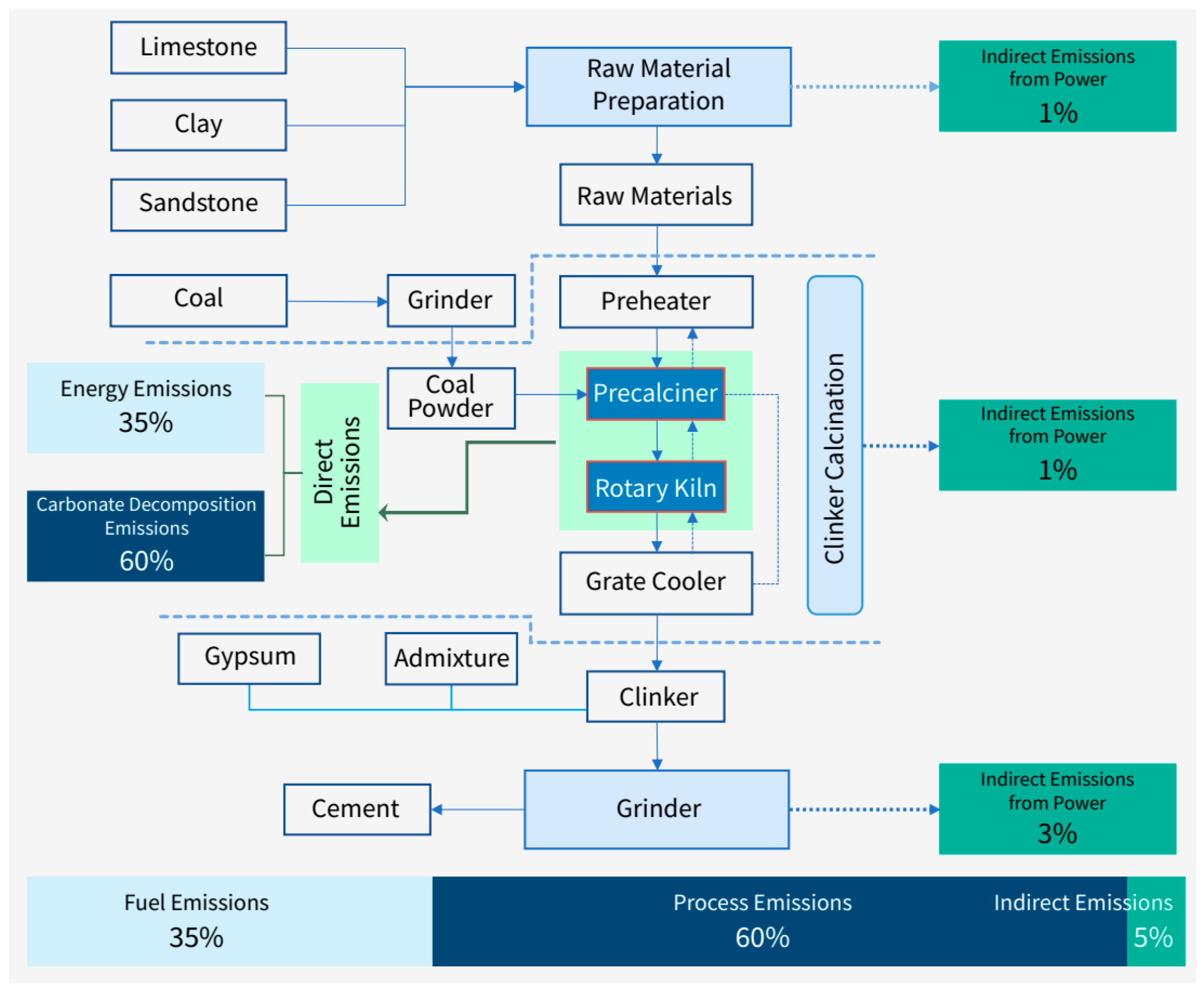

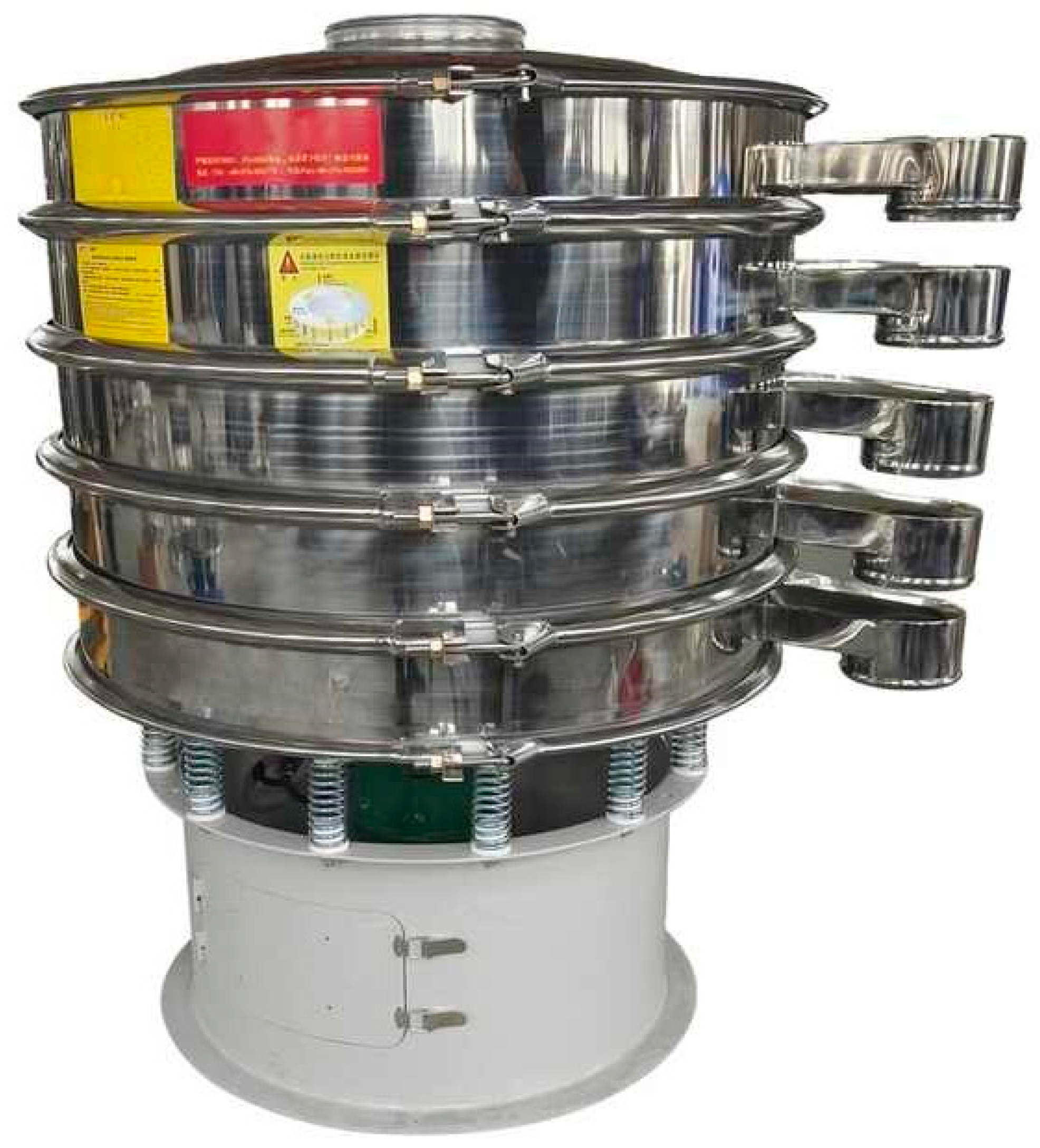
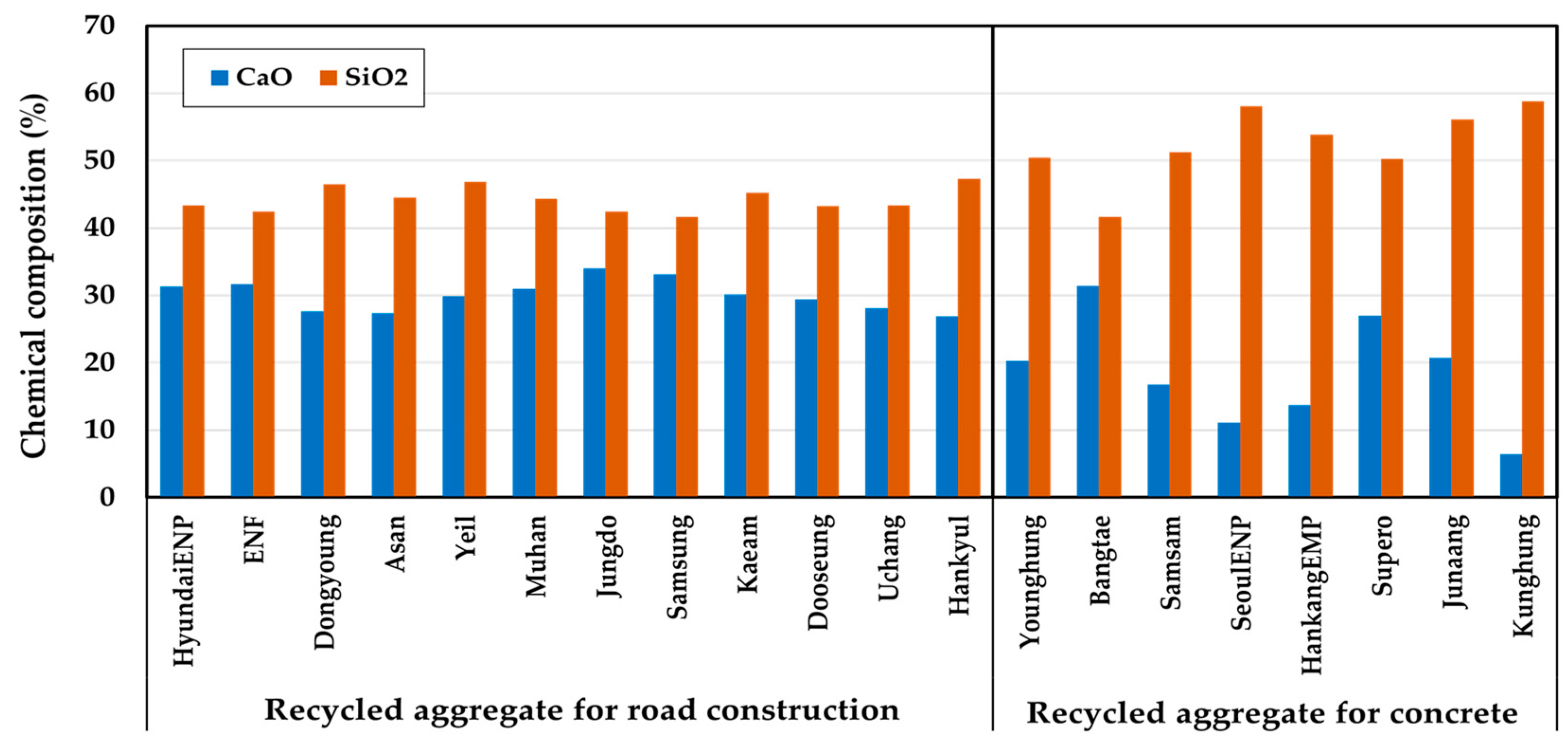


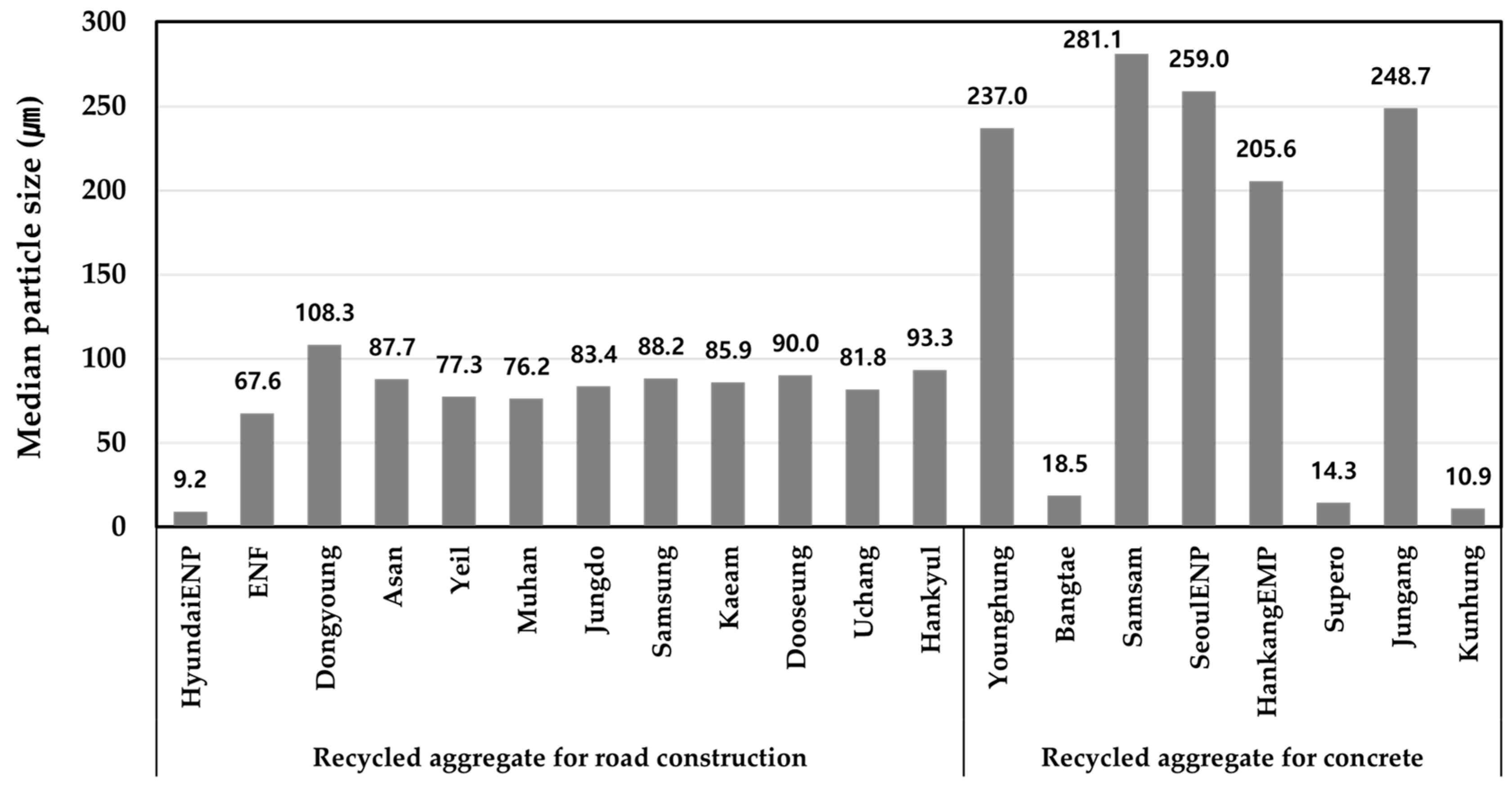
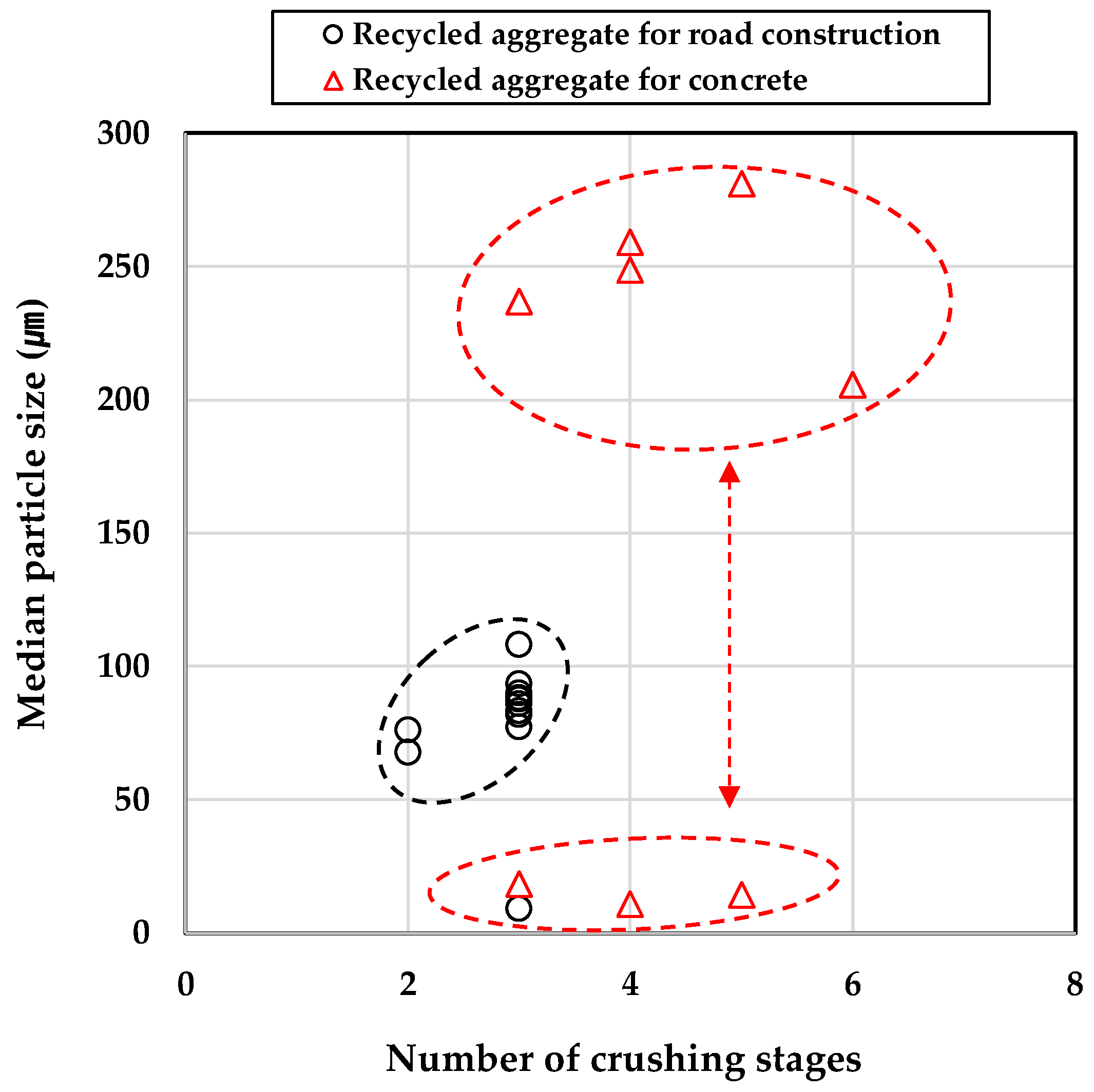


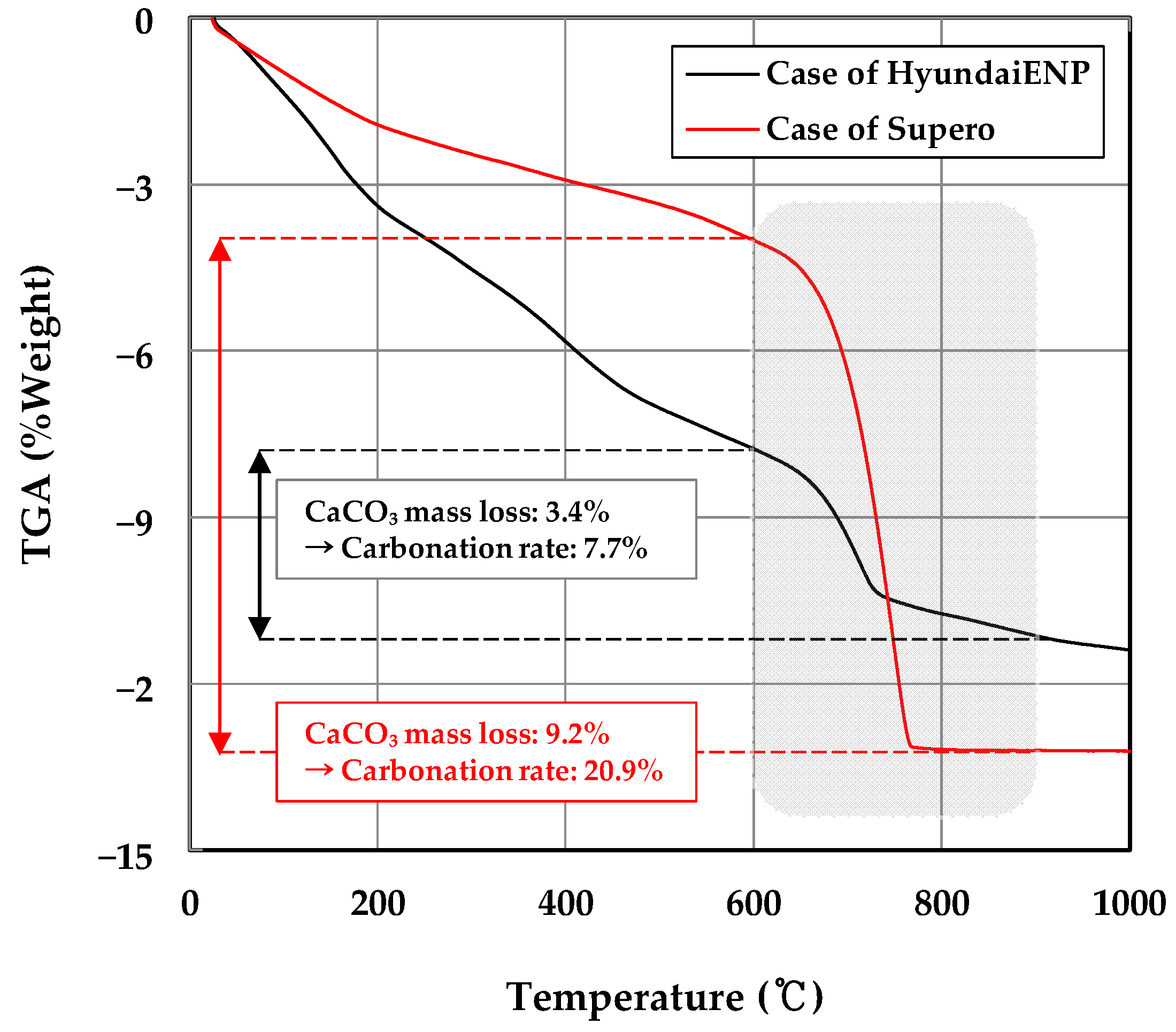
| Category | 2019 | 2020 | 2021 | 2022 | 2023 | Average |
|---|---|---|---|---|---|---|
| Clinker Production (Mt) | 45.9 | 41.8 | 43.4 | 42.8 | 41.9 | 43.2 |
| Mixed Raw Materials Usage (Mt) | 75.8 | 69.1 | 71.7 | 70.8 | 69.3 | 71.3 |
| Limestone Usage (Mt) | 68.2 | 62.2 | 64.6 | 63.7 | 62.3 | 64.2 |
| Limestone-origin CO2 generation (Mt) | 25.7 | 23.4 | 24.3 | 24.0 | 23.5 | 24.2 |
| Analytical Samples | Target Sample | Test Items |
|---|---|---|
| 20 samples | Less than 300 μm waste concrete fine powder |
|
| Principle | Kind | Feature | Shape |
|---|---|---|---|
| Compressive force | Jaw crusher and cone crusher | Crushes concrete blocks to a specific size; cone crusher uses spiral grooves for secondary and tertiary crushing |  |
| Roll crusher | Crushes materials using two rotating rods, typically for stone powder production |  | |
| Impact force | Impact and hammer | Throws aggregate by rotational force, applying impact to crush or peel the surface |  |
| Shear force | Abrasion | Uses friction to peel the surface of aggregates and effectively remove surface paste | 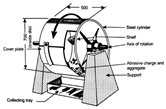 |
| Final Production | Company Name | Crushing Times | Process * | |
|---|---|---|---|---|
| Recycled aggregate for road construction | 1 | HyundaiENP | 3 | J-C-C |
| 2 | ENF | 2 | J-C | |
| 3 | Dongyoung | 3 | J-J-C | |
| 4 | Asan | 3 | J-C-C | |
| 5 | Yeil | 3 | J-C-I | |
| 6 | Muhan | 2 | J-I | |
| 7 | Jungdo | 2 | J-C | |
| 8 | Samsung | 3 | J-J-C | |
| 9 | Kaeam | 3 | J-J-C | |
| 10 | Dooseung | 3 | J-J-C | |
| 11 | Uchang | 3 | J-J-C | |
| 12 | Hankyul | 3 | J-J-C | |
| Recycled aggregate for concrete | 13 | Younghung | 5 | J-J-C-C-I |
| 14 | Bangtae | 6 | J-J-C-I-I-A | |
| 15 | Samsam | 5 | J-J-C-C-A | |
| 16 | SeoulENP | 3 | J-C-A | |
| 17 | HankangEMP | 6 | J-J-C-C-I-A | |
| 18 | Supero | 6 | J-J-C-R-R-I | |
| 19 | Jungang | 5 | J-J-C-S-S | |
| 20 | Kunhung | 4 | J-J-C-A | |
| Sample | CaO | SiO2 | Al2O3 | MgO | K2O | Na2O | F | Cl | Others | |
|---|---|---|---|---|---|---|---|---|---|---|
| Recycled aggregate for road construction | 1 | 31.28 | 43.31 | 12.81 | 2.01 | 2.31 | 0.89 | 0.49 | 0.05 | 6.85 |
| 2 | 31.67 | 42.45 | 11.57 | 3.17 | 2.28 | 1.19 | 0.63 | 0.24 | 6.80 | |
| 3 | 27.59 | 46.50 | 13.39 | 2.38 | 2.34 | 1.09 | 0.49 | 0.03 | 6.20 | |
| 4 | 27.39 | 44.47 | 12.76 | 2.59 | 2.45 | 0.93 | 0.63 | 0.04 | 8.74 | |
| 5 | 29.86 | 46.84 | 11.41 | 1.70 | 2.84 | 0.56 | 0.25 | 0.06 | 6.48 | |
| 6 | 30.98 | 44.28 | 11.38 | 2.10 | 2.80 | 0.83 | 0.52 | 0.09 | 7.02 | |
| 7 | 33.98 | 42.42 | 10.52 | 1.92 | 2.57 | 1.12 | 0.34 | 0.03 | 7.10 | |
| 8 | 33.06 | 41.60 | 12.12 | 1.93 | 2.94 | 1.07 | 0.65 | 0.07 | 6.55 | |
| 9 | 30.15 | 45.25 | 11.65 | 2.06 | 2.91 | 1.04 | 0.35 | 0.06 | 6.54 | |
| 10 | 29.43 | 43.22 | 12.87 | 2.11 | 2.35 | 1.43 | 0.56 | 0.07 | 7.95 | |
| 11 | 28.11 | 43.37 | 13.93 | 2.26 | 2.89 | 1.21 | 0.36 | 0.07 | 7.80 | |
| 12 | 26.91 | 47.29 | 12.66 | 2.16 | 2.90 | 1.18 | 0.50 | 0.03 | 6.35 | |
| standard deviation | 2.17 | 1.79 | 0.94 | 0.37 | 0.26 | 0.21 | 0.12 | 0.05 | 0.73 | |
| Recycled aggregate for concrete | 13 | 20.24 | 50.44 | 13.85 | 1.91 | 3.80 | 1.95 | 0.46 | 0.46 | 6.90 |
| 14 | 31.43 | 41.59 | 12.60 | 2.12 | 2.70 | 0.87 | 0.54 | 0.10 | 8.07 | |
| 15 | 16.74 | 51.26 | 14.64 | 3.24 | 2.50 | 2.27 | 0.44 | 0.05 | 8.87 | |
| 16 | 11.07 | 58.05 | 17.57 | 1.64 | 4.11 | 2.36 | 0.46 | 0.05 | 4.68 | |
| 17 | 13.67 | 53.86 | 16.28 | 1.52 | 5.05 | 1.02 | 0.61 | 0.15 | 7.83 | |
| 18 | 26.98 | 50.28 | 11.59 | 1.37 | 3.49 | 1.48 | 0.47 | 0.02 | 4.32 | |
| 19 | 20.68 | 56.05 | 11.55 | 1.45 | 3.47 | 1.11 | 0.78 | 0.05 | 4.85 | |
| 20 | 6.45 | 58.76 | 14.29 | 2.41 | 6.25 | 1.78 | 0.61 | 0.04 | 9.41 | |
| standard deviation | 7.69 | 5.17 | 2.01 | 0.59 | 1.15 | 0.54 | 0.11 | 0.14 | 1.88 |
Disclaimer/Publisher’s Note: The statements, opinions and data contained in all publications are solely those of the individual author(s) and contributor(s) and not of MDPI and/or the editor(s). MDPI and/or the editor(s) disclaim responsibility for any injury to people or property resulting from any ideas, methods, instructions or products referred to in the content. |
© 2025 by the authors. Licensee MDPI, Basel, Switzerland. This article is an open access article distributed under the terms and conditions of the Creative Commons Attribution (CC BY) license (https://creativecommons.org/licenses/by/4.0/).
Share and Cite
Shin, S.; Kim, G.; Kim, J.; Kim, H.; Park, S. Assessment of the Applicability of Waste Concrete Fine Powder as a Raw Material for Cement Clinker. Recycling 2025, 10, 17. https://doi.org/10.3390/recycling10010017
Shin S, Kim G, Kim J, Kim H, Park S. Assessment of the Applicability of Waste Concrete Fine Powder as a Raw Material for Cement Clinker. Recycling. 2025; 10(1):17. https://doi.org/10.3390/recycling10010017
Chicago/Turabian StyleShin, Sangchul, Geonwoo Kim, Jinman Kim, Haseog Kim, and Sungyu Park. 2025. "Assessment of the Applicability of Waste Concrete Fine Powder as a Raw Material for Cement Clinker" Recycling 10, no. 1: 17. https://doi.org/10.3390/recycling10010017
APA StyleShin, S., Kim, G., Kim, J., Kim, H., & Park, S. (2025). Assessment of the Applicability of Waste Concrete Fine Powder as a Raw Material for Cement Clinker. Recycling, 10(1), 17. https://doi.org/10.3390/recycling10010017






